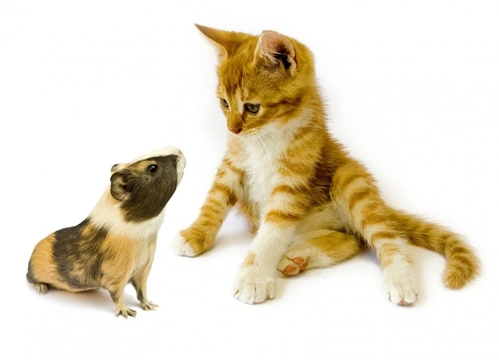
Can Cats & Small Pets Live Together Safely?
If you are an animal lover, you may well have visions of keeping all sorts of pets in your home, although you may also be viewing things through rose tinted glasses and assuming that all of your animals will just get on and live happily together!
When it comes to people who keep cats, many such people automatically discount the possibility of keeping small, furry pets such as mice, rats or hamsters along with the cat for their own safety, but just as many cat owners have worked out ways to keep a variety of different pets within the home, with either supervised or limited interaction between them.
In this article, we will look at some of the logistical challenges of keeping a cat as well as other small furry pets in the same home, and how to get past them. Read on to learn more.
The challenges
The obvious challenge when it comes to keeping smaller pets with cats is that cats are natural and often very successful hunters, who will automatically see the other animal as prey. Your cat might not even need to see the pet in question to get the taste for them, as it were, because they will be able to smell them within the house, and on you too when you have handled them, and so this can lead to a scenario where your cat is always peripherally aware of the other pet, and will be looking for ways to gain access to them!
What type of small furry?
How your cat will react to and treat a smaller furry animal will depend on a range of things, including your cat’s personality and the level of their prey drive, and also, what sort of smaller pet you are thinking of getting.
Mice and hamsters, for instance, are very small and will almost always run from a cat, while fancy rats are often considerably larger, and may be bolder.
Animals like chinchillas and degus are larger still, and ferrets, while mid-way between the size of a cat and a smaller pet, are also carnivorous hunters, whose personalities are markedly different from that of small prey animals.
Larger caged pets and cats
It is often easier to keep larger caged pets such as ferrets, house rabbits or chinchillas with cats than it is to keep smaller pets, because the size of the other animal may keep the cat from seeing them as prey. However, this is by no means a given-many cats will successfully hunt for wild rabbits, and so it depends to a great extent on your own cat!
Additionally, while smaller caged pets can often be kept in their own room that the cat cannot go into, larger pets need larger runs and more interaction with people, which means that they may need to share a room and space with the cat.
Smaller caged pets and cats
As mentioned, smaller caged pets like gerbils, mice and hamsters are natural prey for cats, and unless your cat has a very unique personality, it is likely to be virtually impossible to have such pets outside of the cage while your cat is around without them being threatened and endangered.
For this reason, keeping such pets in their own room where the cat cannot go, and ensuring that the room is pet-proofed to make outside of the cage time safe is usually the best approach.
Rats fall somewhere on the boundary between large and small furry caged pets-while in the wild, cats will usually catch a lot of rats, fancy rats (the type that we keep as pets) are much larger, and often, more confident and bold as a result of being handled by people-and as such, if they do not act like prey to your cat, your cat may not see them as such.
Even so, this is something that you should consider very carefully!
Introductions
While it is wise to keep smaller caged pets well away from your cat altogether, for larger pets, you might want to attempt to integrate and introduce them, and see how they get on. The younger that your cat is and the larger the other pet is when you do this, the better chance you will have of everything going well, and your cat being less likely to see the other animal as prey-and don’t forget that some furry caged pets may well be quite feisty, such as ferrets, and so, this can lead to quite a fight, which is apt to leave both parties injured.
First of all, get your cat used to the smell, sight and presence of the other animals by allowing them into the same room-ensuring of course that the cat cannot get into the cage! Watch the interactions between the pets carefully over the course of some weeks, and then you can make an informed decision as to whether or not you wish to try to introduce the pets, with close supervision in case of any problems.
Comfort
Even if you are 100% confident that your cat cannot get into your pet’s enclosure or attack them, it will not do your smaller pets any good to feel threatened by your cat-such as if your cats stare into the enclosure or smack their paws against the glass.
Try to prevent this from happening so that your smaller pets can feel safe and happy, and do not let your cat stalk your other pets, even if they cannot get to them!



